Business Law Report: Analysis of UK Commercial Law and Regulations
VerifiedAdded on 2020/01/07
|16
|4467
|214
Report
AI Summary
This report provides an analysis of UK business law, focusing on key areas such as the Sales of Goods Act, Consumer Credit, and Agency. It examines a case study involving the purchase of a second-hand car, evaluating the implications of the Sales of Goods Act 1979, including sections related to ownership, description, and satisfactory quality. The report assesses the impact of exclusion clauses and the remedies available to buyers. It further explores different types of consumer credit agreements, including bank loans, hire purchase, and credit sales, and discusses the rights of sellers and buyers. The report also delves into agency agreements, outlining the roles of principals and agents and the different types of agents. Finally, it touches upon the Consumer Protection Act 1987 and product liability, offering a comprehensive overview of relevant legal principles and statutory provisions within the context of UK commercial law.
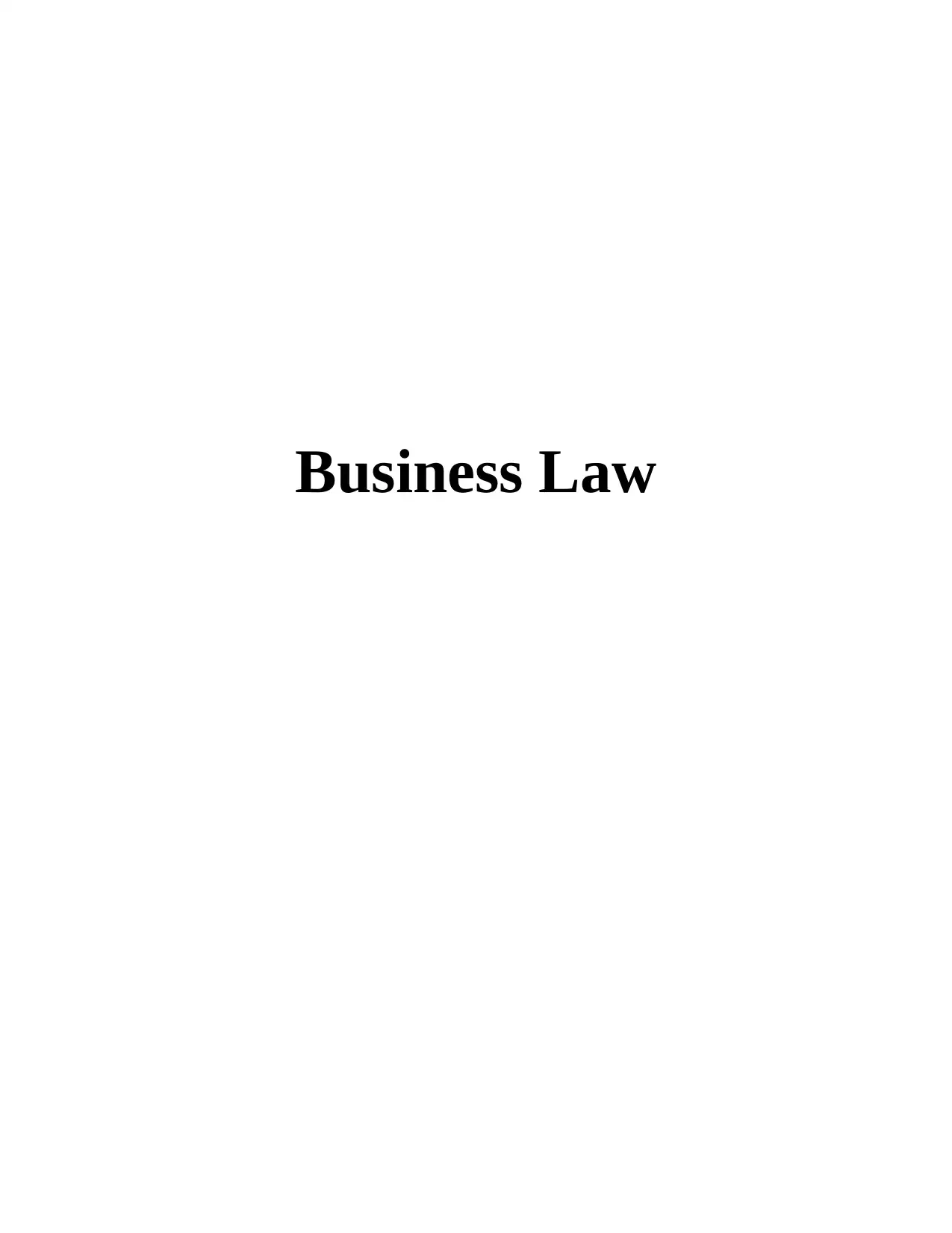
Business Law
Paraphrase This Document
Need a fresh take? Get an instant paraphrase of this document with our AI Paraphraser
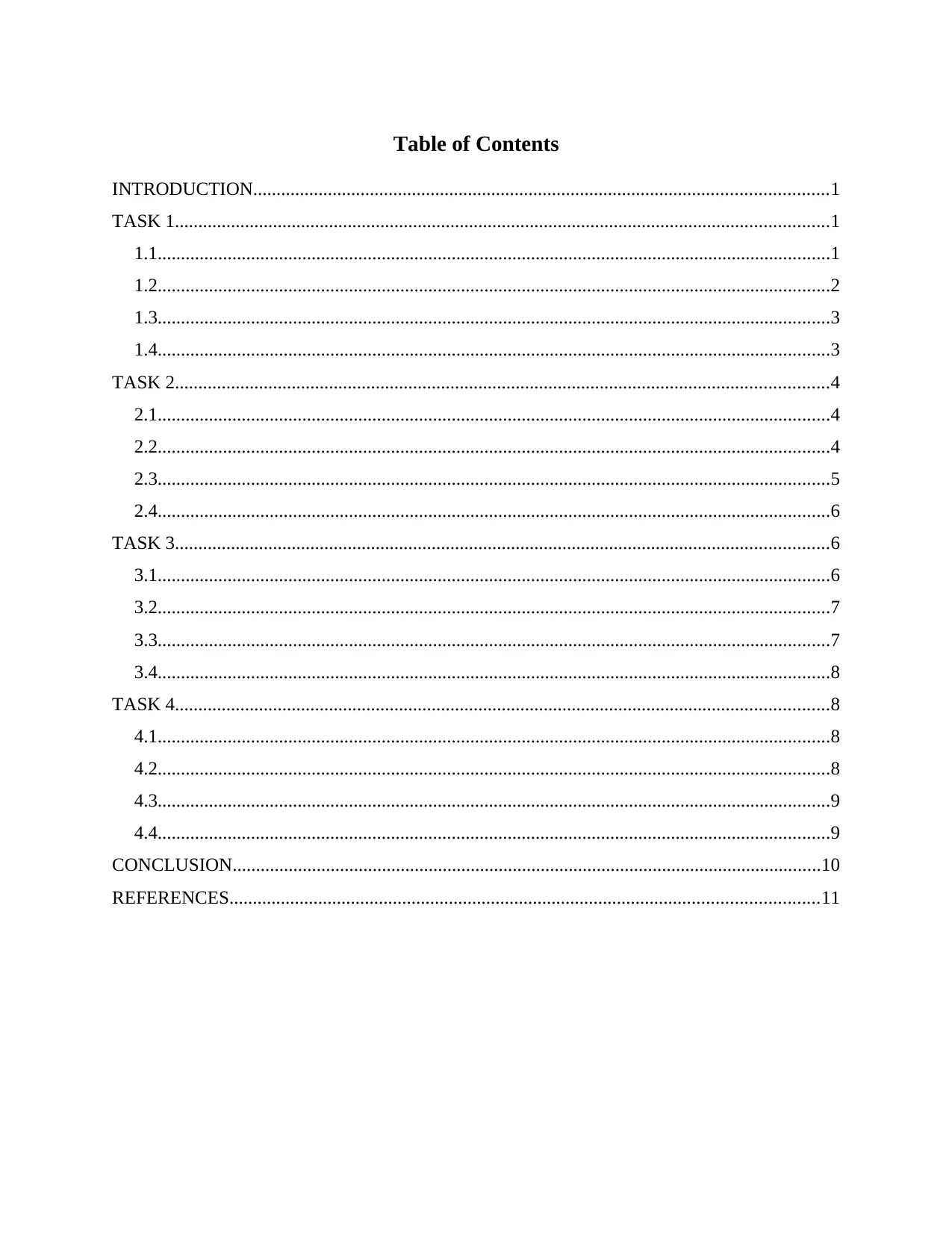
Table of Contents
INTRODUCTION...........................................................................................................................1
TASK 1............................................................................................................................................1
1.1................................................................................................................................................1
1.2................................................................................................................................................2
1.3................................................................................................................................................3
1.4................................................................................................................................................3
TASK 2............................................................................................................................................4
2.1................................................................................................................................................4
2.2................................................................................................................................................4
2.3................................................................................................................................................5
2.4................................................................................................................................................6
TASK 3............................................................................................................................................6
3.1................................................................................................................................................6
3.2................................................................................................................................................7
3.3................................................................................................................................................7
3.4................................................................................................................................................8
TASK 4............................................................................................................................................8
4.1................................................................................................................................................8
4.2................................................................................................................................................8
4.3................................................................................................................................................9
4.4................................................................................................................................................9
CONCLUSION..............................................................................................................................10
REFERENCES..............................................................................................................................11
INTRODUCTION...........................................................................................................................1
TASK 1............................................................................................................................................1
1.1................................................................................................................................................1
1.2................................................................................................................................................2
1.3................................................................................................................................................3
1.4................................................................................................................................................3
TASK 2............................................................................................................................................4
2.1................................................................................................................................................4
2.2................................................................................................................................................4
2.3................................................................................................................................................5
2.4................................................................................................................................................6
TASK 3............................................................................................................................................6
3.1................................................................................................................................................6
3.2................................................................................................................................................7
3.3................................................................................................................................................7
3.4................................................................................................................................................8
TASK 4............................................................................................................................................8
4.1................................................................................................................................................8
4.2................................................................................................................................................8
4.3................................................................................................................................................9
4.4................................................................................................................................................9
CONCLUSION..............................................................................................................................10
REFERENCES..............................................................................................................................11

⊘ This is a preview!⊘
Do you want full access?
Subscribe today to unlock all pages.

Trusted by 1+ million students worldwide
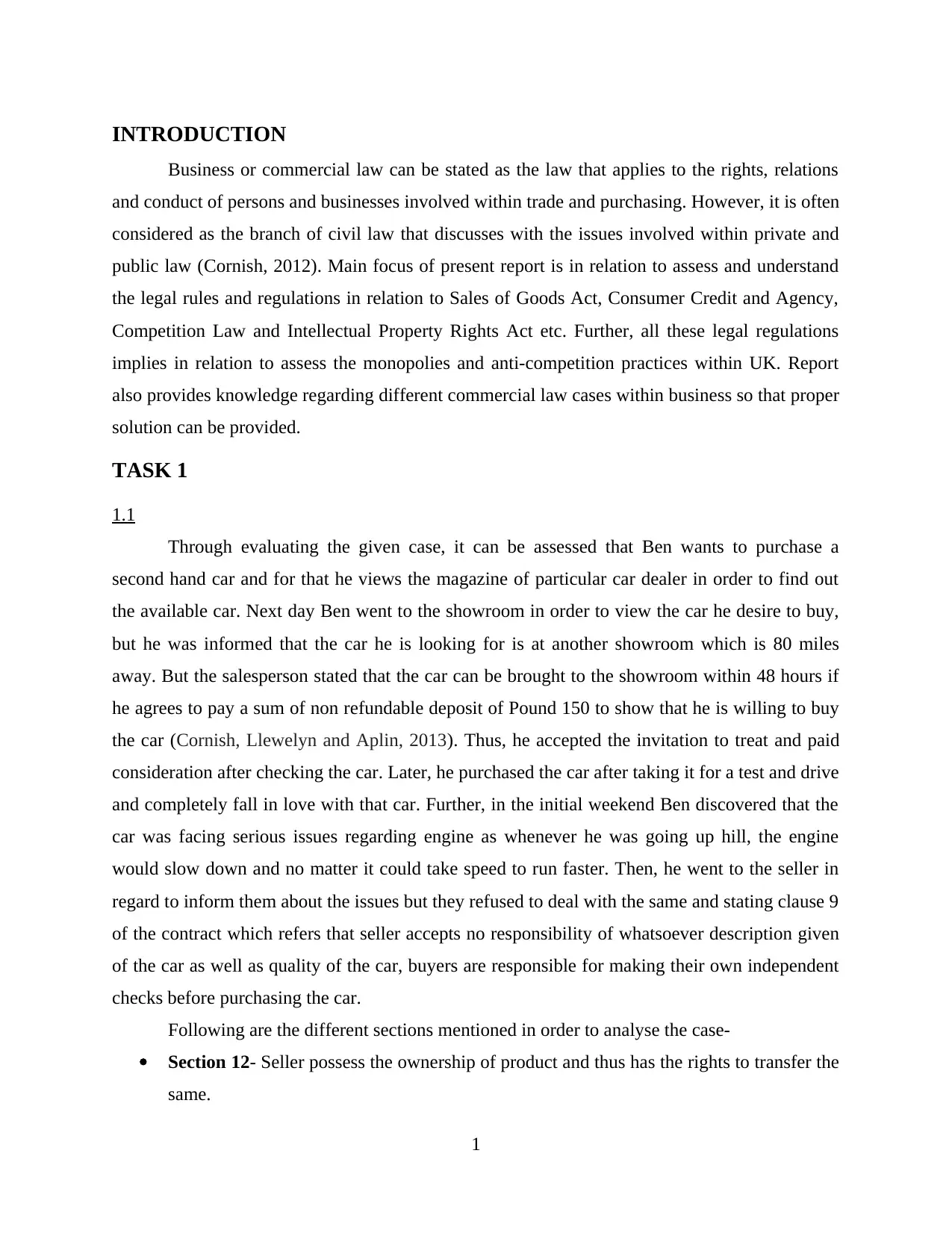
INTRODUCTION
Business or commercial law can be stated as the law that applies to the rights, relations
and conduct of persons and businesses involved within trade and purchasing. However, it is often
considered as the branch of civil law that discusses with the issues involved within private and
public law (Cornish, 2012). Main focus of present report is in relation to assess and understand
the legal rules and regulations in relation to Sales of Goods Act, Consumer Credit and Agency,
Competition Law and Intellectual Property Rights Act etc. Further, all these legal regulations
implies in relation to assess the monopolies and anti-competition practices within UK. Report
also provides knowledge regarding different commercial law cases within business so that proper
solution can be provided.
TASK 1
1.1
Through evaluating the given case, it can be assessed that Ben wants to purchase a
second hand car and for that he views the magazine of particular car dealer in order to find out
the available car. Next day Ben went to the showroom in order to view the car he desire to buy,
but he was informed that the car he is looking for is at another showroom which is 80 miles
away. But the salesperson stated that the car can be brought to the showroom within 48 hours if
he agrees to pay a sum of non refundable deposit of Pound 150 to show that he is willing to buy
the car (Cornish, Llewelyn and Aplin, 2013). Thus, he accepted the invitation to treat and paid
consideration after checking the car. Later, he purchased the car after taking it for a test and drive
and completely fall in love with that car. Further, in the initial weekend Ben discovered that the
car was facing serious issues regarding engine as whenever he was going up hill, the engine
would slow down and no matter it could take speed to run faster. Then, he went to the seller in
regard to inform them about the issues but they refused to deal with the same and stating clause 9
of the contract which refers that seller accepts no responsibility of whatsoever description given
of the car as well as quality of the car, buyers are responsible for making their own independent
checks before purchasing the car.
Following are the different sections mentioned in order to analyse the case-
Section 12- Seller possess the ownership of product and thus has the rights to transfer the
same.
1
Business or commercial law can be stated as the law that applies to the rights, relations
and conduct of persons and businesses involved within trade and purchasing. However, it is often
considered as the branch of civil law that discusses with the issues involved within private and
public law (Cornish, 2012). Main focus of present report is in relation to assess and understand
the legal rules and regulations in relation to Sales of Goods Act, Consumer Credit and Agency,
Competition Law and Intellectual Property Rights Act etc. Further, all these legal regulations
implies in relation to assess the monopolies and anti-competition practices within UK. Report
also provides knowledge regarding different commercial law cases within business so that proper
solution can be provided.
TASK 1
1.1
Through evaluating the given case, it can be assessed that Ben wants to purchase a
second hand car and for that he views the magazine of particular car dealer in order to find out
the available car. Next day Ben went to the showroom in order to view the car he desire to buy,
but he was informed that the car he is looking for is at another showroom which is 80 miles
away. But the salesperson stated that the car can be brought to the showroom within 48 hours if
he agrees to pay a sum of non refundable deposit of Pound 150 to show that he is willing to buy
the car (Cornish, Llewelyn and Aplin, 2013). Thus, he accepted the invitation to treat and paid
consideration after checking the car. Later, he purchased the car after taking it for a test and drive
and completely fall in love with that car. Further, in the initial weekend Ben discovered that the
car was facing serious issues regarding engine as whenever he was going up hill, the engine
would slow down and no matter it could take speed to run faster. Then, he went to the seller in
regard to inform them about the issues but they refused to deal with the same and stating clause 9
of the contract which refers that seller accepts no responsibility of whatsoever description given
of the car as well as quality of the car, buyers are responsible for making their own independent
checks before purchasing the car.
Following are the different sections mentioned in order to analyse the case-
Section 12- Seller possess the ownership of product and thus has the rights to transfer the
same.
1
Paraphrase This Document
Need a fresh take? Get an instant paraphrase of this document with our AI Paraphraser
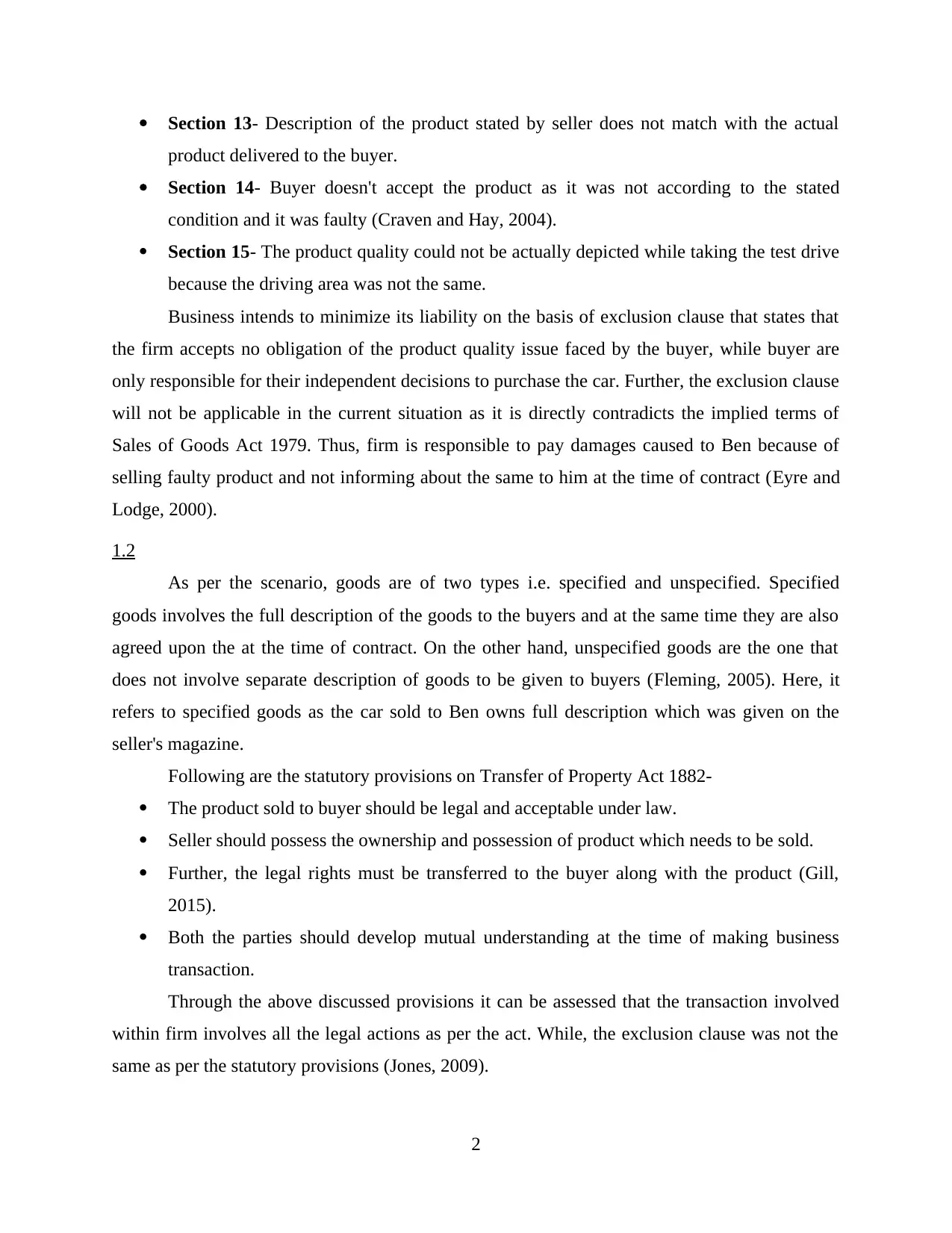
Section 13- Description of the product stated by seller does not match with the actual
product delivered to the buyer.
Section 14- Buyer doesn't accept the product as it was not according to the stated
condition and it was faulty (Craven and Hay, 2004).
Section 15- The product quality could not be actually depicted while taking the test drive
because the driving area was not the same.
Business intends to minimize its liability on the basis of exclusion clause that states that
the firm accepts no obligation of the product quality issue faced by the buyer, while buyer are
only responsible for their independent decisions to purchase the car. Further, the exclusion clause
will not be applicable in the current situation as it is directly contradicts the implied terms of
Sales of Goods Act 1979. Thus, firm is responsible to pay damages caused to Ben because of
selling faulty product and not informing about the same to him at the time of contract (Eyre and
Lodge, 2000).
1.2
As per the scenario, goods are of two types i.e. specified and unspecified. Specified
goods involves the full description of the goods to the buyers and at the same time they are also
agreed upon the at the time of contract. On the other hand, unspecified goods are the one that
does not involve separate description of goods to be given to buyers (Fleming, 2005). Here, it
refers to specified goods as the car sold to Ben owns full description which was given on the
seller's magazine.
Following are the statutory provisions on Transfer of Property Act 1882-
The product sold to buyer should be legal and acceptable under law.
Seller should possess the ownership and possession of product which needs to be sold.
Further, the legal rights must be transferred to the buyer along with the product (Gill,
2015).
Both the parties should develop mutual understanding at the time of making business
transaction.
Through the above discussed provisions it can be assessed that the transaction involved
within firm involves all the legal actions as per the act. While, the exclusion clause was not the
same as per the statutory provisions (Jones, 2009).
2
product delivered to the buyer.
Section 14- Buyer doesn't accept the product as it was not according to the stated
condition and it was faulty (Craven and Hay, 2004).
Section 15- The product quality could not be actually depicted while taking the test drive
because the driving area was not the same.
Business intends to minimize its liability on the basis of exclusion clause that states that
the firm accepts no obligation of the product quality issue faced by the buyer, while buyer are
only responsible for their independent decisions to purchase the car. Further, the exclusion clause
will not be applicable in the current situation as it is directly contradicts the implied terms of
Sales of Goods Act 1979. Thus, firm is responsible to pay damages caused to Ben because of
selling faulty product and not informing about the same to him at the time of contract (Eyre and
Lodge, 2000).
1.2
As per the scenario, goods are of two types i.e. specified and unspecified. Specified
goods involves the full description of the goods to the buyers and at the same time they are also
agreed upon the at the time of contract. On the other hand, unspecified goods are the one that
does not involve separate description of goods to be given to buyers (Fleming, 2005). Here, it
refers to specified goods as the car sold to Ben owns full description which was given on the
seller's magazine.
Following are the statutory provisions on Transfer of Property Act 1882-
The product sold to buyer should be legal and acceptable under law.
Seller should possess the ownership and possession of product which needs to be sold.
Further, the legal rights must be transferred to the buyer along with the product (Gill,
2015).
Both the parties should develop mutual understanding at the time of making business
transaction.
Through the above discussed provisions it can be assessed that the transaction involved
within firm involves all the legal actions as per the act. While, the exclusion clause was not the
same as per the statutory provisions (Jones, 2009).
2
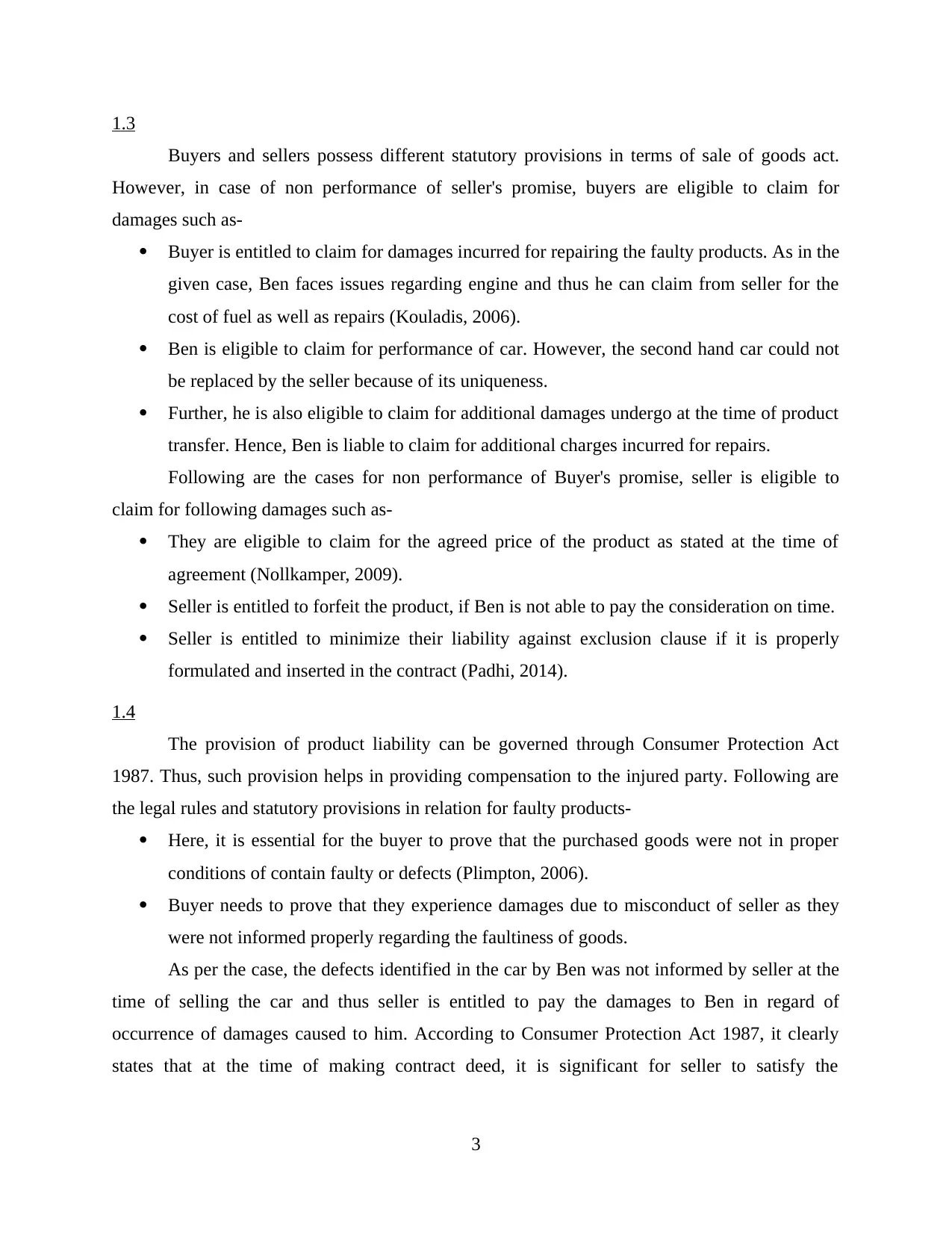
1.3
Buyers and sellers possess different statutory provisions in terms of sale of goods act.
However, in case of non performance of seller's promise, buyers are eligible to claim for
damages such as-
Buyer is entitled to claim for damages incurred for repairing the faulty products. As in the
given case, Ben faces issues regarding engine and thus he can claim from seller for the
cost of fuel as well as repairs (Kouladis, 2006).
Ben is eligible to claim for performance of car. However, the second hand car could not
be replaced by the seller because of its uniqueness.
Further, he is also eligible to claim for additional damages undergo at the time of product
transfer. Hence, Ben is liable to claim for additional charges incurred for repairs.
Following are the cases for non performance of Buyer's promise, seller is eligible to
claim for following damages such as-
They are eligible to claim for the agreed price of the product as stated at the time of
agreement (Nollkamper, 2009).
Seller is entitled to forfeit the product, if Ben is not able to pay the consideration on time.
Seller is entitled to minimize their liability against exclusion clause if it is properly
formulated and inserted in the contract (Padhi, 2014).
1.4
The provision of product liability can be governed through Consumer Protection Act
1987. Thus, such provision helps in providing compensation to the injured party. Following are
the legal rules and statutory provisions in relation for faulty products-
Here, it is essential for the buyer to prove that the purchased goods were not in proper
conditions of contain faulty or defects (Plimpton, 2006).
Buyer needs to prove that they experience damages due to misconduct of seller as they
were not informed properly regarding the faultiness of goods.
As per the case, the defects identified in the car by Ben was not informed by seller at the
time of selling the car and thus seller is entitled to pay the damages to Ben in regard of
occurrence of damages caused to him. According to Consumer Protection Act 1987, it clearly
states that at the time of making contract deed, it is significant for seller to satisfy the
3
Buyers and sellers possess different statutory provisions in terms of sale of goods act.
However, in case of non performance of seller's promise, buyers are eligible to claim for
damages such as-
Buyer is entitled to claim for damages incurred for repairing the faulty products. As in the
given case, Ben faces issues regarding engine and thus he can claim from seller for the
cost of fuel as well as repairs (Kouladis, 2006).
Ben is eligible to claim for performance of car. However, the second hand car could not
be replaced by the seller because of its uniqueness.
Further, he is also eligible to claim for additional damages undergo at the time of product
transfer. Hence, Ben is liable to claim for additional charges incurred for repairs.
Following are the cases for non performance of Buyer's promise, seller is eligible to
claim for following damages such as-
They are eligible to claim for the agreed price of the product as stated at the time of
agreement (Nollkamper, 2009).
Seller is entitled to forfeit the product, if Ben is not able to pay the consideration on time.
Seller is entitled to minimize their liability against exclusion clause if it is properly
formulated and inserted in the contract (Padhi, 2014).
1.4
The provision of product liability can be governed through Consumer Protection Act
1987. Thus, such provision helps in providing compensation to the injured party. Following are
the legal rules and statutory provisions in relation for faulty products-
Here, it is essential for the buyer to prove that the purchased goods were not in proper
conditions of contain faulty or defects (Plimpton, 2006).
Buyer needs to prove that they experience damages due to misconduct of seller as they
were not informed properly regarding the faultiness of goods.
As per the case, the defects identified in the car by Ben was not informed by seller at the
time of selling the car and thus seller is entitled to pay the damages to Ben in regard of
occurrence of damages caused to him. According to Consumer Protection Act 1987, it clearly
states that at the time of making contract deed, it is significant for seller to satisfy the
3
⊘ This is a preview!⊘
Do you want full access?
Subscribe today to unlock all pages.

Trusted by 1+ million students worldwide
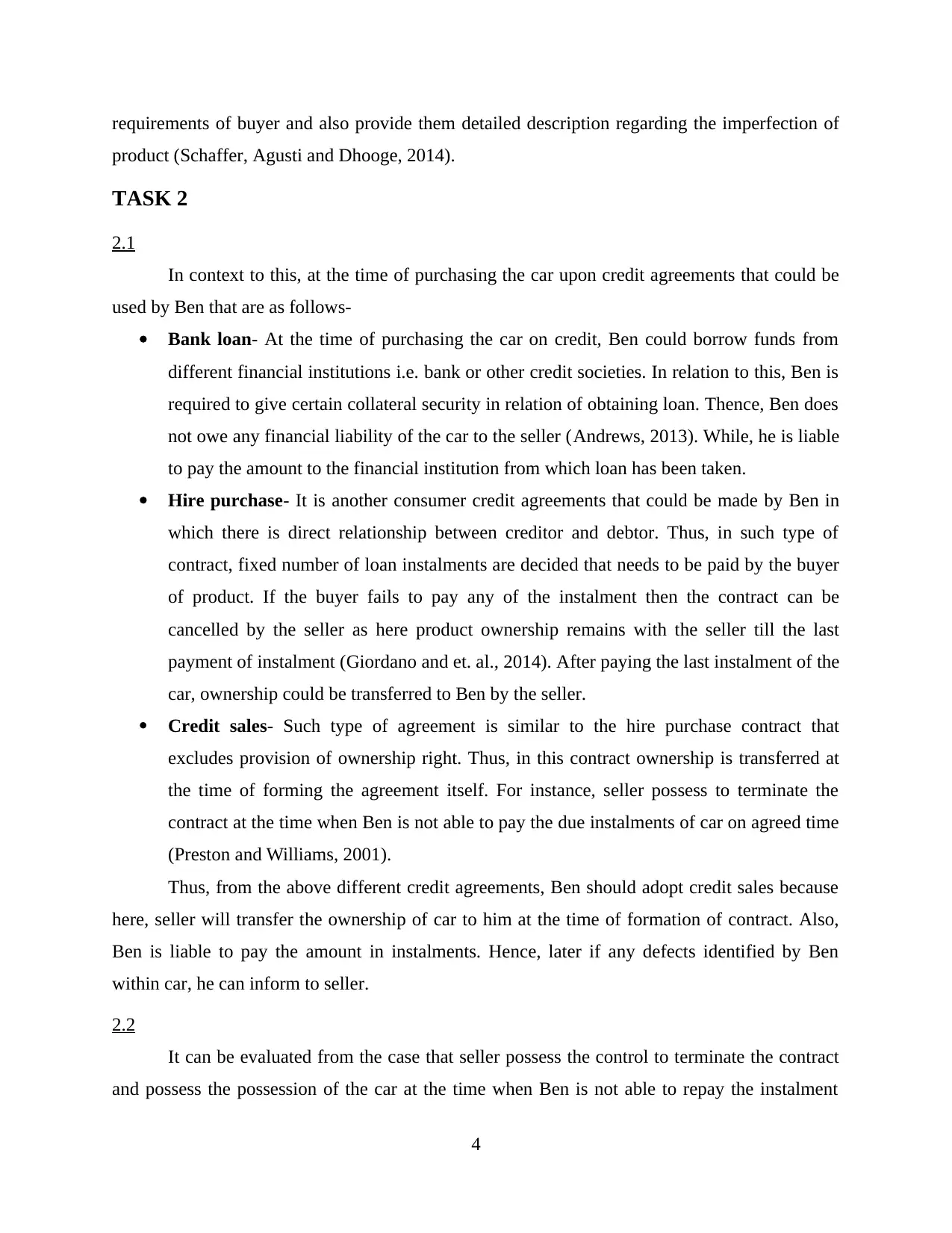
requirements of buyer and also provide them detailed description regarding the imperfection of
product (Schaffer, Agusti and Dhooge, 2014).
TASK 2
2.1
In context to this, at the time of purchasing the car upon credit agreements that could be
used by Ben that are as follows-
Bank loan- At the time of purchasing the car on credit, Ben could borrow funds from
different financial institutions i.e. bank or other credit societies. In relation to this, Ben is
required to give certain collateral security in relation of obtaining loan. Thence, Ben does
not owe any financial liability of the car to the seller (Andrews, 2013). While, he is liable
to pay the amount to the financial institution from which loan has been taken.
Hire purchase- It is another consumer credit agreements that could be made by Ben in
which there is direct relationship between creditor and debtor. Thus, in such type of
contract, fixed number of loan instalments are decided that needs to be paid by the buyer
of product. If the buyer fails to pay any of the instalment then the contract can be
cancelled by the seller as here product ownership remains with the seller till the last
payment of instalment (Giordano and et. al., 2014). After paying the last instalment of the
car, ownership could be transferred to Ben by the seller.
Credit sales- Such type of agreement is similar to the hire purchase contract that
excludes provision of ownership right. Thus, in this contract ownership is transferred at
the time of forming the agreement itself. For instance, seller possess to terminate the
contract at the time when Ben is not able to pay the due instalments of car on agreed time
(Preston and Williams, 2001).
Thus, from the above different credit agreements, Ben should adopt credit sales because
here, seller will transfer the ownership of car to him at the time of formation of contract. Also,
Ben is liable to pay the amount in instalments. Hence, later if any defects identified by Ben
within car, he can inform to seller.
2.2
It can be evaluated from the case that seller possess the control to terminate the contract
and possess the possession of the car at the time when Ben is not able to repay the instalment
4
product (Schaffer, Agusti and Dhooge, 2014).
TASK 2
2.1
In context to this, at the time of purchasing the car upon credit agreements that could be
used by Ben that are as follows-
Bank loan- At the time of purchasing the car on credit, Ben could borrow funds from
different financial institutions i.e. bank or other credit societies. In relation to this, Ben is
required to give certain collateral security in relation of obtaining loan. Thence, Ben does
not owe any financial liability of the car to the seller (Andrews, 2013). While, he is liable
to pay the amount to the financial institution from which loan has been taken.
Hire purchase- It is another consumer credit agreements that could be made by Ben in
which there is direct relationship between creditor and debtor. Thus, in such type of
contract, fixed number of loan instalments are decided that needs to be paid by the buyer
of product. If the buyer fails to pay any of the instalment then the contract can be
cancelled by the seller as here product ownership remains with the seller till the last
payment of instalment (Giordano and et. al., 2014). After paying the last instalment of the
car, ownership could be transferred to Ben by the seller.
Credit sales- Such type of agreement is similar to the hire purchase contract that
excludes provision of ownership right. Thus, in this contract ownership is transferred at
the time of forming the agreement itself. For instance, seller possess to terminate the
contract at the time when Ben is not able to pay the due instalments of car on agreed time
(Preston and Williams, 2001).
Thus, from the above different credit agreements, Ben should adopt credit sales because
here, seller will transfer the ownership of car to him at the time of formation of contract. Also,
Ben is liable to pay the amount in instalments. Hence, later if any defects identified by Ben
within car, he can inform to seller.
2.2
It can be evaluated from the case that seller possess the control to terminate the contract
and possess the possession of the car at the time when Ben is not able to repay the instalment
4
Paraphrase This Document
Need a fresh take? Get an instant paraphrase of this document with our AI Paraphraser
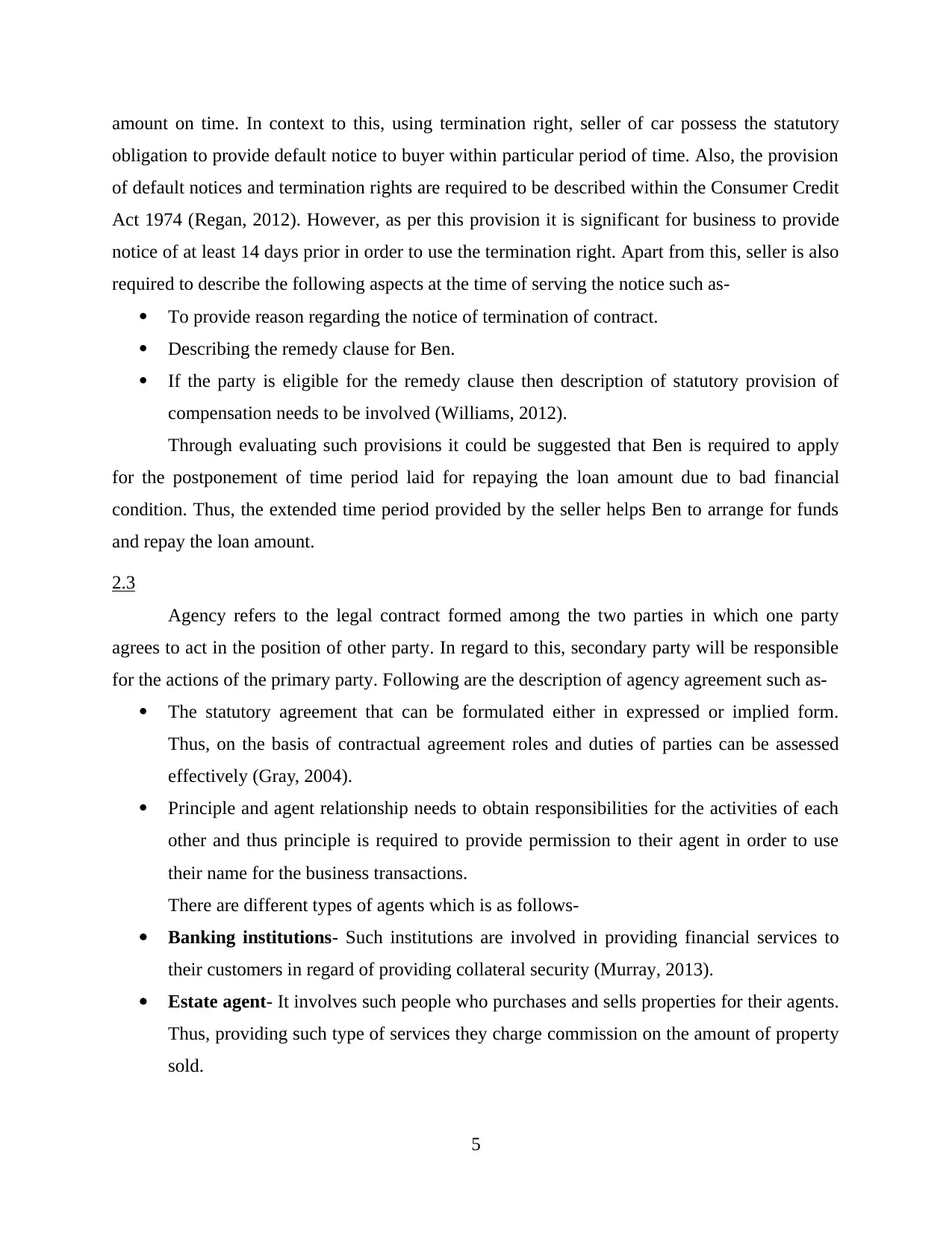
amount on time. In context to this, using termination right, seller of car possess the statutory
obligation to provide default notice to buyer within particular period of time. Also, the provision
of default notices and termination rights are required to be described within the Consumer Credit
Act 1974 (Regan, 2012). However, as per this provision it is significant for business to provide
notice of at least 14 days prior in order to use the termination right. Apart from this, seller is also
required to describe the following aspects at the time of serving the notice such as-
To provide reason regarding the notice of termination of contract.
Describing the remedy clause for Ben.
If the party is eligible for the remedy clause then description of statutory provision of
compensation needs to be involved (Williams, 2012).
Through evaluating such provisions it could be suggested that Ben is required to apply
for the postponement of time period laid for repaying the loan amount due to bad financial
condition. Thus, the extended time period provided by the seller helps Ben to arrange for funds
and repay the loan amount.
2.3
Agency refers to the legal contract formed among the two parties in which one party
agrees to act in the position of other party. In regard to this, secondary party will be responsible
for the actions of the primary party. Following are the description of agency agreement such as-
The statutory agreement that can be formulated either in expressed or implied form.
Thus, on the basis of contractual agreement roles and duties of parties can be assessed
effectively (Gray, 2004).
Principle and agent relationship needs to obtain responsibilities for the activities of each
other and thus principle is required to provide permission to their agent in order to use
their name for the business transactions.
There are different types of agents which is as follows-
Banking institutions- Such institutions are involved in providing financial services to
their customers in regard of providing collateral security (Murray, 2013).
Estate agent- It involves such people who purchases and sells properties for their agents.
Thus, providing such type of services they charge commission on the amount of property
sold.
5
obligation to provide default notice to buyer within particular period of time. Also, the provision
of default notices and termination rights are required to be described within the Consumer Credit
Act 1974 (Regan, 2012). However, as per this provision it is significant for business to provide
notice of at least 14 days prior in order to use the termination right. Apart from this, seller is also
required to describe the following aspects at the time of serving the notice such as-
To provide reason regarding the notice of termination of contract.
Describing the remedy clause for Ben.
If the party is eligible for the remedy clause then description of statutory provision of
compensation needs to be involved (Williams, 2012).
Through evaluating such provisions it could be suggested that Ben is required to apply
for the postponement of time period laid for repaying the loan amount due to bad financial
condition. Thus, the extended time period provided by the seller helps Ben to arrange for funds
and repay the loan amount.
2.3
Agency refers to the legal contract formed among the two parties in which one party
agrees to act in the position of other party. In regard to this, secondary party will be responsible
for the actions of the primary party. Following are the description of agency agreement such as-
The statutory agreement that can be formulated either in expressed or implied form.
Thus, on the basis of contractual agreement roles and duties of parties can be assessed
effectively (Gray, 2004).
Principle and agent relationship needs to obtain responsibilities for the activities of each
other and thus principle is required to provide permission to their agent in order to use
their name for the business transactions.
There are different types of agents which is as follows-
Banking institutions- Such institutions are involved in providing financial services to
their customers in regard of providing collateral security (Murray, 2013).
Estate agent- It involves such people who purchases and sells properties for their agents.
Thus, providing such type of services they charge commission on the amount of property
sold.
5
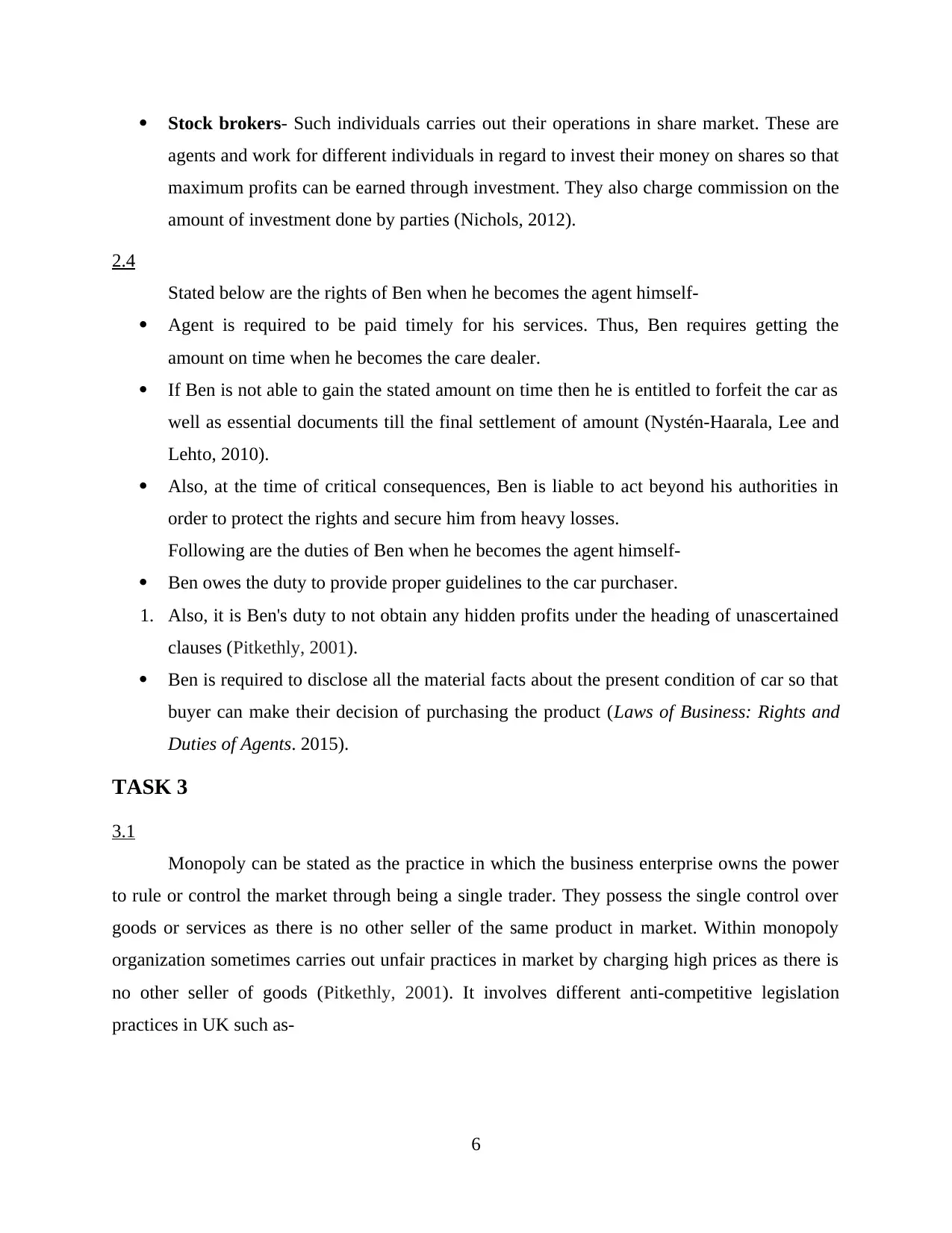
Stock brokers- Such individuals carries out their operations in share market. These are
agents and work for different individuals in regard to invest their money on shares so that
maximum profits can be earned through investment. They also charge commission on the
amount of investment done by parties (Nichols, 2012).
2.4
Stated below are the rights of Ben when he becomes the agent himself-
Agent is required to be paid timely for his services. Thus, Ben requires getting the
amount on time when he becomes the care dealer.
If Ben is not able to gain the stated amount on time then he is entitled to forfeit the car as
well as essential documents till the final settlement of amount (Nystén-Haarala, Lee and
Lehto, 2010).
Also, at the time of critical consequences, Ben is liable to act beyond his authorities in
order to protect the rights and secure him from heavy losses.
Following are the duties of Ben when he becomes the agent himself-
Ben owes the duty to provide proper guidelines to the car purchaser.
1. Also, it is Ben's duty to not obtain any hidden profits under the heading of unascertained
clauses (Pitkethly, 2001).
Ben is required to disclose all the material facts about the present condition of car so that
buyer can make their decision of purchasing the product (Laws of Business: Rights and
Duties of Agents. 2015).
TASK 3
3.1
Monopoly can be stated as the practice in which the business enterprise owns the power
to rule or control the market through being a single trader. They possess the single control over
goods or services as there is no other seller of the same product in market. Within monopoly
organization sometimes carries out unfair practices in market by charging high prices as there is
no other seller of goods (Pitkethly, 2001). It involves different anti-competitive legislation
practices in UK such as-
6
agents and work for different individuals in regard to invest their money on shares so that
maximum profits can be earned through investment. They also charge commission on the
amount of investment done by parties (Nichols, 2012).
2.4
Stated below are the rights of Ben when he becomes the agent himself-
Agent is required to be paid timely for his services. Thus, Ben requires getting the
amount on time when he becomes the care dealer.
If Ben is not able to gain the stated amount on time then he is entitled to forfeit the car as
well as essential documents till the final settlement of amount (Nystén-Haarala, Lee and
Lehto, 2010).
Also, at the time of critical consequences, Ben is liable to act beyond his authorities in
order to protect the rights and secure him from heavy losses.
Following are the duties of Ben when he becomes the agent himself-
Ben owes the duty to provide proper guidelines to the car purchaser.
1. Also, it is Ben's duty to not obtain any hidden profits under the heading of unascertained
clauses (Pitkethly, 2001).
Ben is required to disclose all the material facts about the present condition of car so that
buyer can make their decision of purchasing the product (Laws of Business: Rights and
Duties of Agents. 2015).
TASK 3
3.1
Monopoly can be stated as the practice in which the business enterprise owns the power
to rule or control the market through being a single trader. They possess the single control over
goods or services as there is no other seller of the same product in market. Within monopoly
organization sometimes carries out unfair practices in market by charging high prices as there is
no other seller of goods (Pitkethly, 2001). It involves different anti-competitive legislation
practices in UK such as-
6
⊘ This is a preview!⊘
Do you want full access?
Subscribe today to unlock all pages.

Trusted by 1+ million students worldwide
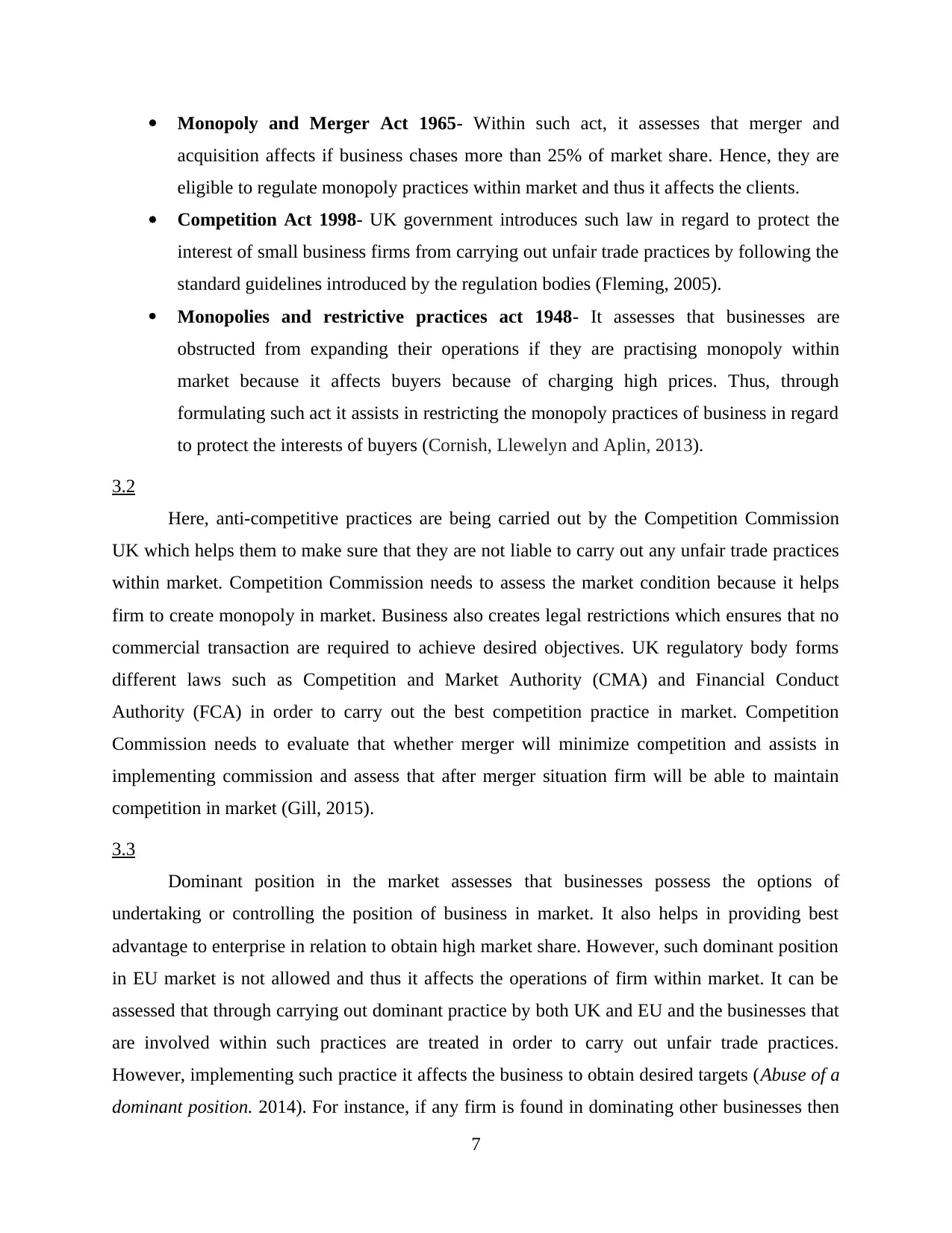
Monopoly and Merger Act 1965- Within such act, it assesses that merger and
acquisition affects if business chases more than 25% of market share. Hence, they are
eligible to regulate monopoly practices within market and thus it affects the clients.
Competition Act 1998- UK government introduces such law in regard to protect the
interest of small business firms from carrying out unfair trade practices by following the
standard guidelines introduced by the regulation bodies (Fleming, 2005).
Monopolies and restrictive practices act 1948- It assesses that businesses are
obstructed from expanding their operations if they are practising monopoly within
market because it affects buyers because of charging high prices. Thus, through
formulating such act it assists in restricting the monopoly practices of business in regard
to protect the interests of buyers (Cornish, Llewelyn and Aplin, 2013).
3.2
Here, anti-competitive practices are being carried out by the Competition Commission
UK which helps them to make sure that they are not liable to carry out any unfair trade practices
within market. Competition Commission needs to assess the market condition because it helps
firm to create monopoly in market. Business also creates legal restrictions which ensures that no
commercial transaction are required to achieve desired objectives. UK regulatory body forms
different laws such as Competition and Market Authority (CMA) and Financial Conduct
Authority (FCA) in order to carry out the best competition practice in market. Competition
Commission needs to evaluate that whether merger will minimize competition and assists in
implementing commission and assess that after merger situation firm will be able to maintain
competition in market (Gill, 2015).
3.3
Dominant position in the market assesses that businesses possess the options of
undertaking or controlling the position of business in market. It also helps in providing best
advantage to enterprise in relation to obtain high market share. However, such dominant position
in EU market is not allowed and thus it affects the operations of firm within market. It can be
assessed that through carrying out dominant practice by both UK and EU and the businesses that
are involved within such practices are treated in order to carry out unfair trade practices.
However, implementing such practice it affects the business to obtain desired targets (Abuse of a
dominant position. 2014). For instance, if any firm is found in dominating other businesses then
7
acquisition affects if business chases more than 25% of market share. Hence, they are
eligible to regulate monopoly practices within market and thus it affects the clients.
Competition Act 1998- UK government introduces such law in regard to protect the
interest of small business firms from carrying out unfair trade practices by following the
standard guidelines introduced by the regulation bodies (Fleming, 2005).
Monopolies and restrictive practices act 1948- It assesses that businesses are
obstructed from expanding their operations if they are practising monopoly within
market because it affects buyers because of charging high prices. Thus, through
formulating such act it assists in restricting the monopoly practices of business in regard
to protect the interests of buyers (Cornish, Llewelyn and Aplin, 2013).
3.2
Here, anti-competitive practices are being carried out by the Competition Commission
UK which helps them to make sure that they are not liable to carry out any unfair trade practices
within market. Competition Commission needs to assess the market condition because it helps
firm to create monopoly in market. Business also creates legal restrictions which ensures that no
commercial transaction are required to achieve desired objectives. UK regulatory body forms
different laws such as Competition and Market Authority (CMA) and Financial Conduct
Authority (FCA) in order to carry out the best competition practice in market. Competition
Commission needs to evaluate that whether merger will minimize competition and assists in
implementing commission and assess that after merger situation firm will be able to maintain
competition in market (Gill, 2015).
3.3
Dominant position in the market assesses that businesses possess the options of
undertaking or controlling the position of business in market. It also helps in providing best
advantage to enterprise in relation to obtain high market share. However, such dominant position
in EU market is not allowed and thus it affects the operations of firm within market. It can be
assessed that through carrying out dominant practice by both UK and EU and the businesses that
are involved within such practices are treated in order to carry out unfair trade practices.
However, implementing such practice it affects the business to obtain desired targets (Abuse of a
dominant position. 2014). For instance, if any firm is found in dominating other businesses then
7
Paraphrase This Document
Need a fresh take? Get an instant paraphrase of this document with our AI Paraphraser
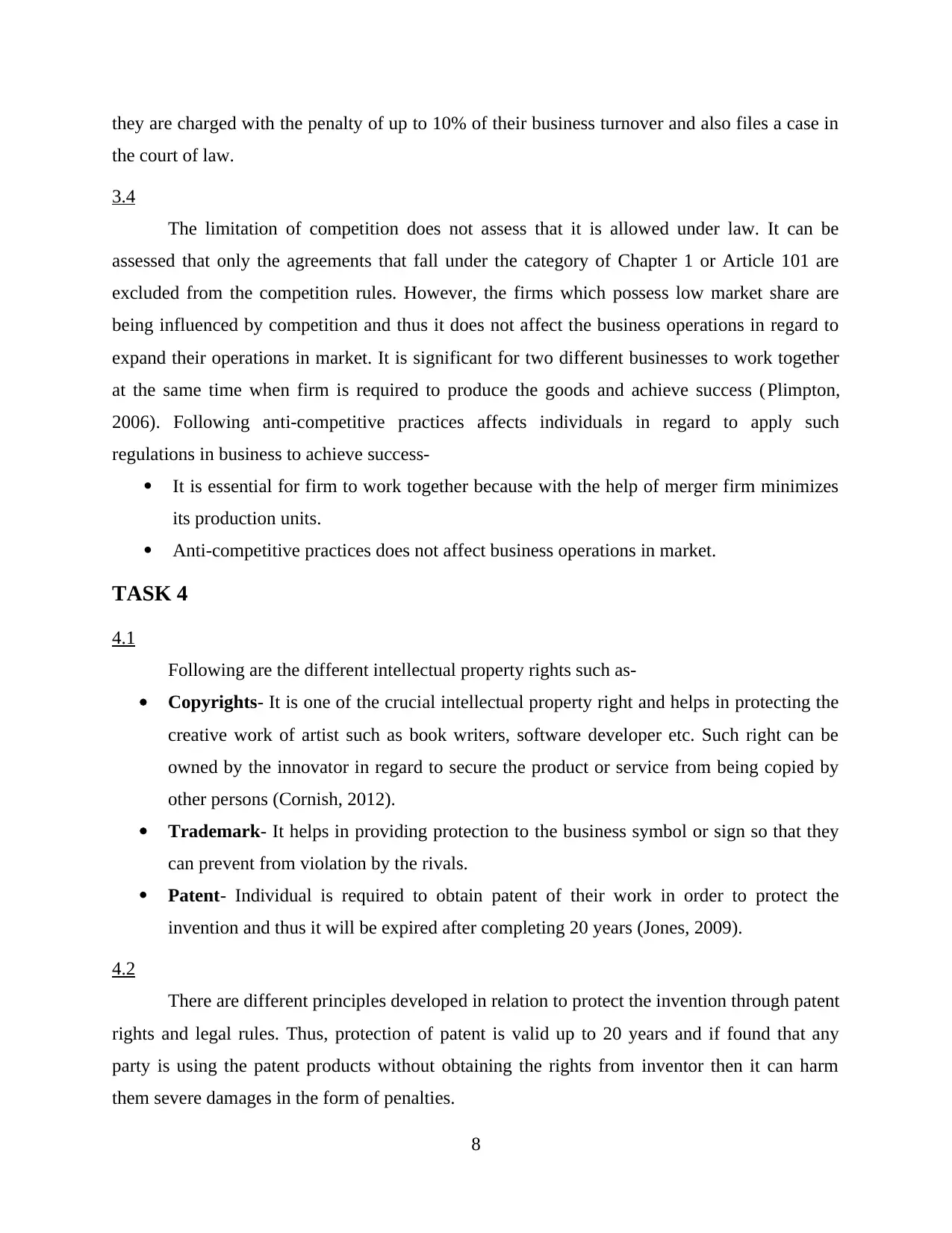
they are charged with the penalty of up to 10% of their business turnover and also files a case in
the court of law.
3.4
The limitation of competition does not assess that it is allowed under law. It can be
assessed that only the agreements that fall under the category of Chapter 1 or Article 101 are
excluded from the competition rules. However, the firms which possess low market share are
being influenced by competition and thus it does not affect the business operations in regard to
expand their operations in market. It is significant for two different businesses to work together
at the same time when firm is required to produce the goods and achieve success (Plimpton,
2006). Following anti-competitive practices affects individuals in regard to apply such
regulations in business to achieve success-
It is essential for firm to work together because with the help of merger firm minimizes
its production units.
Anti-competitive practices does not affect business operations in market.
TASK 4
4.1
Following are the different intellectual property rights such as-
Copyrights- It is one of the crucial intellectual property right and helps in protecting the
creative work of artist such as book writers, software developer etc. Such right can be
owned by the innovator in regard to secure the product or service from being copied by
other persons (Cornish, 2012).
Trademark- It helps in providing protection to the business symbol or sign so that they
can prevent from violation by the rivals.
Patent- Individual is required to obtain patent of their work in order to protect the
invention and thus it will be expired after completing 20 years (Jones, 2009).
4.2
There are different principles developed in relation to protect the invention through patent
rights and legal rules. Thus, protection of patent is valid up to 20 years and if found that any
party is using the patent products without obtaining the rights from inventor then it can harm
them severe damages in the form of penalties.
8
the court of law.
3.4
The limitation of competition does not assess that it is allowed under law. It can be
assessed that only the agreements that fall under the category of Chapter 1 or Article 101 are
excluded from the competition rules. However, the firms which possess low market share are
being influenced by competition and thus it does not affect the business operations in regard to
expand their operations in market. It is significant for two different businesses to work together
at the same time when firm is required to produce the goods and achieve success (Plimpton,
2006). Following anti-competitive practices affects individuals in regard to apply such
regulations in business to achieve success-
It is essential for firm to work together because with the help of merger firm minimizes
its production units.
Anti-competitive practices does not affect business operations in market.
TASK 4
4.1
Following are the different intellectual property rights such as-
Copyrights- It is one of the crucial intellectual property right and helps in protecting the
creative work of artist such as book writers, software developer etc. Such right can be
owned by the innovator in regard to secure the product or service from being copied by
other persons (Cornish, 2012).
Trademark- It helps in providing protection to the business symbol or sign so that they
can prevent from violation by the rivals.
Patent- Individual is required to obtain patent of their work in order to protect the
invention and thus it will be expired after completing 20 years (Jones, 2009).
4.2
There are different principles developed in relation to protect the invention through patent
rights and legal rules. Thus, protection of patent is valid up to 20 years and if found that any
party is using the patent products without obtaining the rights from inventor then it can harm
them severe damages in the form of penalties.
8
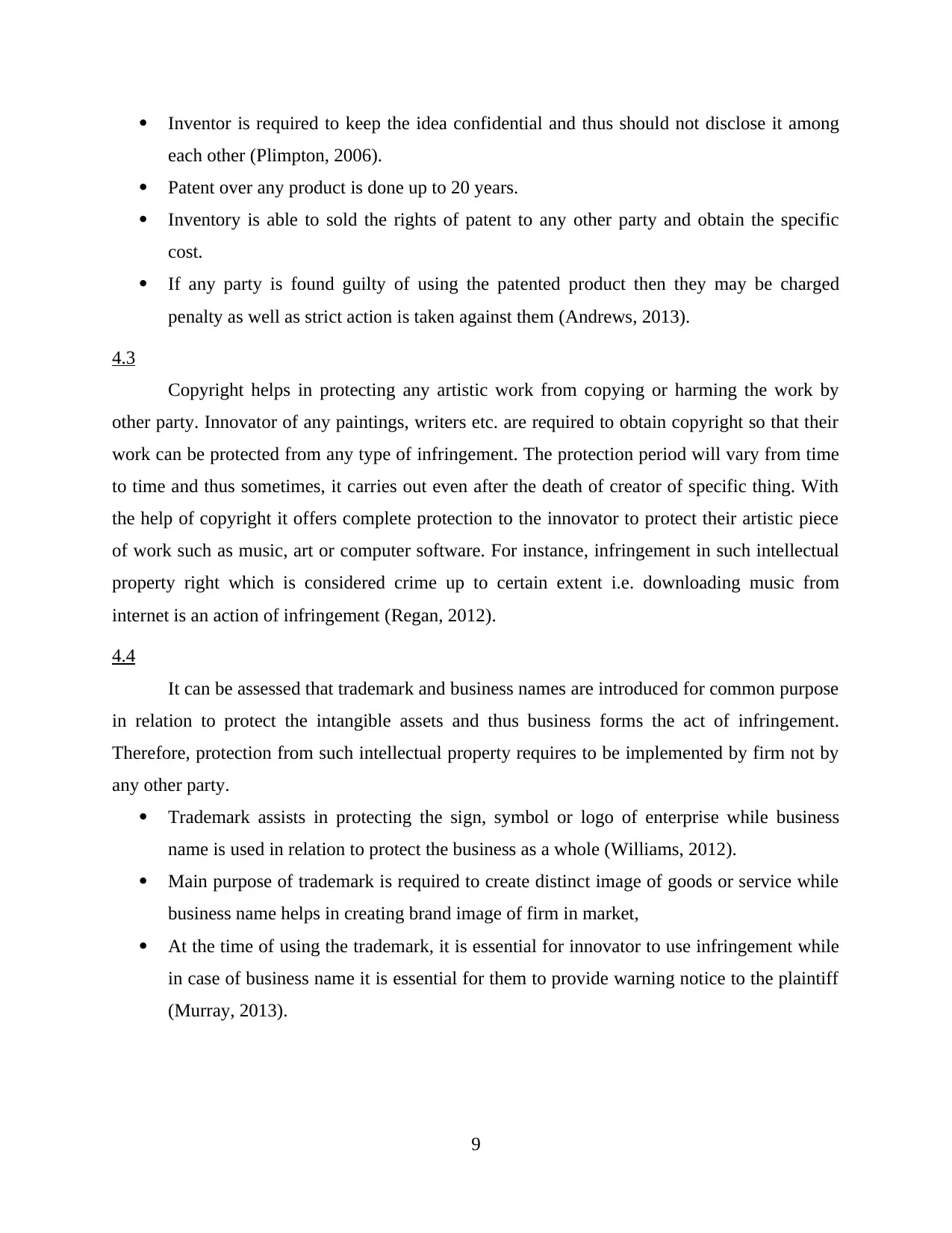
Inventor is required to keep the idea confidential and thus should not disclose it among
each other (Plimpton, 2006).
Patent over any product is done up to 20 years.
Inventory is able to sold the rights of patent to any other party and obtain the specific
cost.
If any party is found guilty of using the patented product then they may be charged
penalty as well as strict action is taken against them (Andrews, 2013).
4.3
Copyright helps in protecting any artistic work from copying or harming the work by
other party. Innovator of any paintings, writers etc. are required to obtain copyright so that their
work can be protected from any type of infringement. The protection period will vary from time
to time and thus sometimes, it carries out even after the death of creator of specific thing. With
the help of copyright it offers complete protection to the innovator to protect their artistic piece
of work such as music, art or computer software. For instance, infringement in such intellectual
property right which is considered crime up to certain extent i.e. downloading music from
internet is an action of infringement (Regan, 2012).
4.4
It can be assessed that trademark and business names are introduced for common purpose
in relation to protect the intangible assets and thus business forms the act of infringement.
Therefore, protection from such intellectual property requires to be implemented by firm not by
any other party.
Trademark assists in protecting the sign, symbol or logo of enterprise while business
name is used in relation to protect the business as a whole (Williams, 2012).
Main purpose of trademark is required to create distinct image of goods or service while
business name helps in creating brand image of firm in market,
At the time of using the trademark, it is essential for innovator to use infringement while
in case of business name it is essential for them to provide warning notice to the plaintiff
(Murray, 2013).
9
each other (Plimpton, 2006).
Patent over any product is done up to 20 years.
Inventory is able to sold the rights of patent to any other party and obtain the specific
cost.
If any party is found guilty of using the patented product then they may be charged
penalty as well as strict action is taken against them (Andrews, 2013).
4.3
Copyright helps in protecting any artistic work from copying or harming the work by
other party. Innovator of any paintings, writers etc. are required to obtain copyright so that their
work can be protected from any type of infringement. The protection period will vary from time
to time and thus sometimes, it carries out even after the death of creator of specific thing. With
the help of copyright it offers complete protection to the innovator to protect their artistic piece
of work such as music, art or computer software. For instance, infringement in such intellectual
property right which is considered crime up to certain extent i.e. downloading music from
internet is an action of infringement (Regan, 2012).
4.4
It can be assessed that trademark and business names are introduced for common purpose
in relation to protect the intangible assets and thus business forms the act of infringement.
Therefore, protection from such intellectual property requires to be implemented by firm not by
any other party.
Trademark assists in protecting the sign, symbol or logo of enterprise while business
name is used in relation to protect the business as a whole (Williams, 2012).
Main purpose of trademark is required to create distinct image of goods or service while
business name helps in creating brand image of firm in market,
At the time of using the trademark, it is essential for innovator to use infringement while
in case of business name it is essential for them to provide warning notice to the plaintiff
(Murray, 2013).
9
⊘ This is a preview!⊘
Do you want full access?
Subscribe today to unlock all pages.

Trusted by 1+ million students worldwide
1 out of 16
Related Documents
Your All-in-One AI-Powered Toolkit for Academic Success.
+13062052269
info@desklib.com
Available 24*7 on WhatsApp / Email
![[object Object]](/_next/static/media/star-bottom.7253800d.svg)
Unlock your academic potential
Copyright © 2020–2025 A2Z Services. All Rights Reserved. Developed and managed by ZUCOL.





